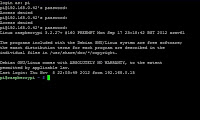 From the beginning of this project, I was curious to know if people would connect to my teapot. I initially planned to create a counter or a statistics module simple PHP. But after discovering Google Analytics, I finally decided to use it.
From the beginning of this project, I was curious to know if people would connect to my teapot. I initially planned to create a counter or a statistics module simple PHP. But after discovering Google Analytics, I finally decided to use it.
Of course, very precise statistics aren't necessary for a simple teapot project, but this module can be activated simply by adding a javascript code on the page to be checked, which made the task very easy.
Since the implementation of Analytics on November 4th, the teapot received 574 unique visitors. The first surprise came from a peak of 143 visits in one day, I can't explain it. But Google Analytics also provides impressive details on the website visitors. You can know the browser, the origin website, the used browser and other relevant information such as country of origin of visitors. This information was what I was most curious about.
As I mentioned my site to friends, I received many visits from France: 109. I also received 109 visits from the United States. What surprised me most is that the first country of my visitors is Finland with 110 visitors. But is it really a surprise that the country that gave us Linus Torvalds, Nokia phones and Angry Birds also hosts many geeks interested in the error 418?

























